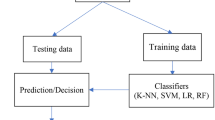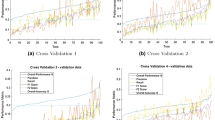Abstract
This paper presents an application of a random forest based classifier that aims at recognizing flawed products in a highly automated production environment. Within the course of this paper, some data set and application features are highlighted that make the underlying classification problem rather complex and hinders the usage of machine learning algorithms straight out-of-the-box. The findings regarding these features and how to treat the concluded challenges are highlighted in a abstracted and generalized manner.
Chapter PDF
Similar content being viewed by others
References
Henmi, T., Deng, M., Yoshinaga, S.: Early Detection of Plant Faults by Using Machine Learning. Int. Conf. on Advanced Mechatronic Systems (ICAMechS), 2016
Zidek, K., Maxim, V.: Diagnostics of Product Defects by Clustering and Machine Learning Classification Algorithm. Journal of Automation and Control, vol.3, 2015
Meshram, A., Haas, C.: Anomaly Detection in Industrial Networks using Machine Learning: A Roadmap. Machine Learning for Cyber Physical Systems: Selected papers from the International Conference ML4CPS 2016. Ed.: J. Beyerer, Springer, pp. 65–72, 2017
Gèron, A.: Hands-On Machine Learning with Scikit-Learn & TensorFLow. O’Reilly, 2017
Breiman, L.: Random Forests. Machine Learning, pp. 5–32, vol. 7, Kluwer Academic Publishers, 2001
Rashid, T., Neuronale Netze selbst programmieren. O’Reilly, 2017
Lemaître, G., Nogueira, F., Aridas, C.K.: Imbalanced-learn: A Python Toolbox to Tackle the Curse of Imbalanced Datasets in Machine Learning. Journal of Machine Learning Research, vol. 18, pp. 1-5, 2017
Batista, G.E.A.P.A., Prati, R.C., Monard, M.C.: A Study of the Behavior of Several Methods for Balancing Machine Learning Training Data. ACM SIGKDD, vol. 6 (1), pp. 20–29, 2004
Ahmad, M.W., Mourshed, M., Rezgui, Y.: Trees vs Neurons: Comparison between Random Forest and ANN for High-Resolution Prediction of Building Energy Consumption. Energy and Buildings, Elsevier, vol. 147, pp. 77–89, 2017
Zhang, Y., Guo, W., Ray, S.: On the Consistency of Feature Selection With Lasso for Non-linear Targets. Proc. of the 33rd Int. Conference on Machine Learning, vol. 48, pp. 183–191, 2016
Eitrich, T., Kless, A., Druska, C., Meyer, W., Grotendorst, J.: Classification of Highly Unbalanced CYP450 Data of Drugs Using Cost Sensitive Machine Learning Techniques. Journal of Chemical Information and Modeling, vol. 47 (1), pp. 92–103, 2007
Wang, S., Yao, X.: Multiclass Imbalance Problems: Analysis and Potential Solutions. Systems Man Cybernetics Part B - Journal IEEE Transactions on Cybernetics, vol. 42, pp. 1119–1130, 2012
Kubat, M., Matwin, S.: Addressing the Course of Imbalanced Training Sets: One- Sided Selection. Proc. of the 14th Int. Conference on Machine Learning, pp. 217–225, 1997
Wyner, A.J., Olson, M., Bleich, J., Mease, D.: Explaining the Success of AdaBoost and Random Forests as Interpolating Classifiers. Journal of Machine Learning Research, vol. 18, pp. 48:1–48:33, 2017
Friedman, J.: Greedy Function Approximation: A Gradient Boosting Machine. Annals of Statistics, pp. 1189–1232, 2001
Liaw, A., Wiener, M.: Classification and Regression by Randomforest. R news, vol. 2 (3), pp. 18–22, 2002
Wainberg, M., Alipanahi, B., Frey, B.,J.: Are Random Forests Truly the Best Classifiers?. Journal of Machine Learning Research, vol. 17, pp. 110:1–110:5, 2016
Fernández-Delgado, M., Cernadas, E., Barro, S., Amorim, D: Do we Need Hundreds of Classifiers to Solve RealWorld Classification Problems? Journal of Machine Learning Research, vol. 15, pp. 3133–3181, 2014
Ahmad, W. M., Mourshed, M., Rezgui, Y.: Trees vs Neurons: Comparison between random forest and ANN for high-resolution prediction of building energy consumption Journal on Energy and Buildings, vol. 147, pp. 77–89, 2017
Author information
Authors and Affiliations
Corresponding author
Editor information
Editors and Affiliations
Rights and permissions
Open Access This chapter is licensed under the terms of the Creative Commons Attribution 4.0 International License (http://creativecommons.org/licenses/by/4.0/), which permits use, sharing, adaptation, distribution and reproduction in any medium or format, as long as you give appropriate credit to the original author(s) and the source, provide a link to the Creative Commons licence and indicate if changes were made.
The images or other third party material in this chapter are included in the chapter's Creative Commons licence, unless indicated otherwise in a credit line to the material. If material is not included in the chapter's Creative Commons licence and your intended use is not permitted by statutory regulation or exceeds the permitted use, you will need to obtain permission directly from the copyright holder.
Copyright information
© 2019 The Author(s)
About this paper
Cite this paper
Gröner, G. (2019). A Random Forest Based Classifier for Error Prediction of Highly Individualized Products. In: Beyerer, J., Kühnert, C., Niggemann, O. (eds) Machine Learning for Cyber Physical Systems. Technologien für die intelligente Automation, vol 9. Springer Vieweg, Berlin, Heidelberg. https://doi.org/10.1007/978-3-662-58485-9_4
Download citation
DOI: https://doi.org/10.1007/978-3-662-58485-9_4
Published:
Publisher Name: Springer Vieweg, Berlin, Heidelberg
Print ISBN: 978-3-662-58484-2
Online ISBN: 978-3-662-58485-9
eBook Packages: Intelligent Technologies and RoboticsIntelligent Technologies and Robotics (R0)




